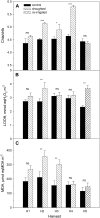Gradual soil water depletion results in reversible changes of gene expression, protein profiles, ecophysiology, and growth performance in Populus euphratica, a poplar growing in arid regions
- PMID: 17158588
- PMCID: PMC1803728
- DOI: 10.1104/pp.106.088708
Gradual soil water depletion results in reversible changes of gene expression, protein profiles, ecophysiology, and growth performance in Populus euphratica, a poplar growing in arid regions
Abstract
The responses of Populus euphratica Oliv. plants to soil water deficit were assessed by analyzing gene expression, protein profiles, and several plant performance criteria to understand the acclimation of plants to soil water deficit. Young, vegetatively propagated plants originating from an arid, saline field site were submitted to a gradually increasing water deficit for 4 weeks in a greenhouse and were allowed to recover for 10 d after full reirrigation. Time-dependent changes and intensity of the perturbations induced in shoot and root growth, xylem anatomy, gas exchange, and water status were recorded. The expression profiles of approximately 6,340 genes and of proteins and metabolites (pigments, soluble carbohydrates, and oxidative compounds) were also recorded in mature leaves and in roots (gene expression only) at four stress levels and after recovery. Drought successively induced shoot growth cessation, stomatal closure, moderate increases in oxidative stress-related compounds, loss of CO2 assimilation, and root growth reduction. These effects were almost fully reversible, indicating that acclimation was dominant over injury. The physiological responses were paralleled by fully reversible transcriptional changes, including only 1.5% of the genes on the array. Protein profiles displayed greater changes than transcript levels. Among the identified proteins for which expressed sequence tags were present on the array, no correlation was found between transcript and protein abundance. Acclimation to water deficit involves the regulation of different networks of genes in roots and shoots. Such diverse requirements for protecting and maintaining the function of different plant organs may render plant engineering or breeding toward improved drought tolerance more complex than previously anticipated.
Figures









References
-
- Akashi K, Nishimura N, Ishida Y, Yokota A (2004) Potent hydroxyl radical-scavenging activity of drought-induced type-2 metallothionein in wild watermelon. Biochem Biophys Res Commun 323 72–78 - PubMed
-
- Aussenac G (2000) Interactions between forest stands and microclimate: ecophysiological aspects and consequences for silviculture. Ann Sci 57 287–301
-
- Bartels D, Souer E (2003) Molecular responses of higher plants to dehydration. In H Hirt, K Shinozaki, eds, Topics in Current Genetics: Plant Response to Abiotic Stress, Vol 4. Springer Verlag, Heidelberg, pp 9–38
Publication types
MeSH terms
Substances
LinkOut - more resources
Full Text Sources
Molecular Biology Databases

